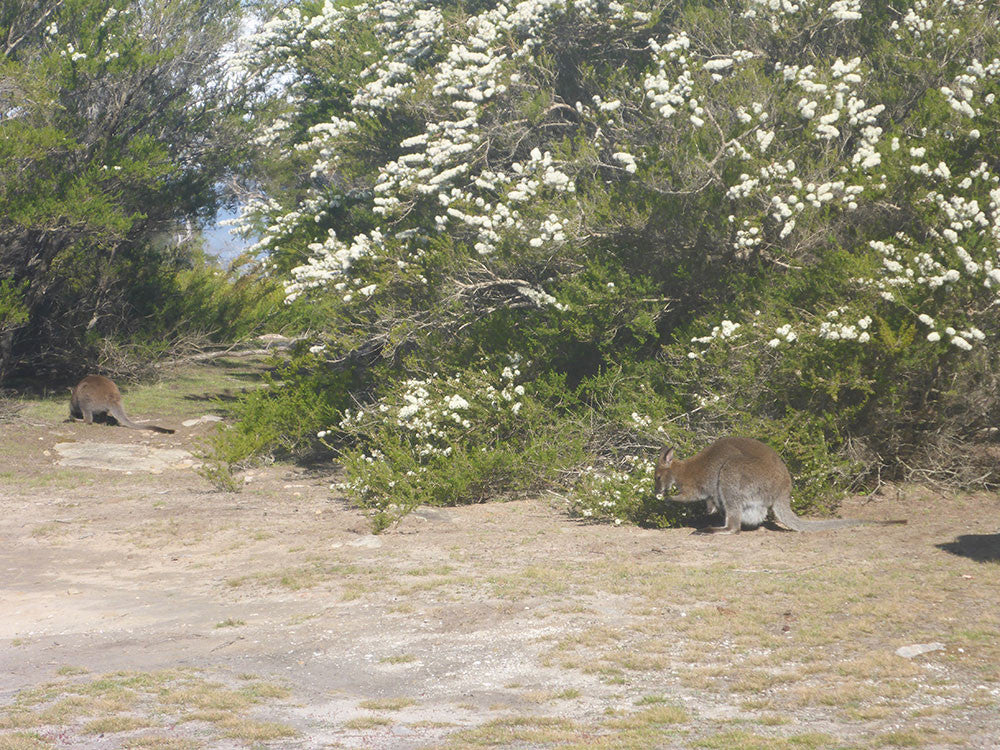Australia is known for having one of the most biologically diverse ecosystems in the world. In fact, 80% of Australian plant species are endemic to the Australian continent, meaning the species are not natively found anywhere else in the world. One example of this is Australian Kunzea.
As of January 2017, there are 66 recorded species of Kunzea across the Australian Plant Census, The Australian Plant Name Index and the Kew World Checklist of Selected Plant Families. Each of these species is comprised of varying concentrates of the key constituents that make Kunzea Oil so unique. Some of these constituents include alpha-pinene, viridifloral, globulol and cineole.
The first formal and documented description of the Kunzea plant was published in 1828 by Ludwig Reichenbach in his book Conspectus Regni Vegetabilis. He referred to three species of Kunzea: capitate, ericifolia and corifolia (now known as ambigua). The genus Kunzea was named after Reichenbach's friend, botanist and naturalist Gustav Kunze.
Origin of Kunzea ambigua
Let's start by exploring the origin of the word ambigua. An English botanist by the name of James Edward Smith described Kunzea ambigua as Leptospermum ambiguum.
Leptospermum is attributed to the plant's similarities to Tea Tree and other genera within the Myrtaceae family. Ambiguum is the Latin adjective for wandering and changing, which is a suitable description of this hardy and adaptable plant. It wasn’t until 1917 that another English botanist, George Claridge Druce, gave the species its binomial name (or botanical name), Kunzea ambigua.
According to the Encyclopaedia of Australian Plants Suitable for Cultivation, Kunzea ambigua was one of the first native Australian plants introduced into England for cultivation and study. The species is most commonly found growing wild in sandy soils along coastal regions and has been cited as attractive to native insects, birds and small animals. Witnesses would observe these animals seeking shelter under the branches of the Kunzea plant and it was thought to provide protection from ticks and mites, hence the common name“tick-bush” was soon adopted.

There have been numerous studies since then that have indicated that Kunzea ambigua is more efficient in treating existing insect bites, infections and infestations - as referenced by Mark Webb (Well-Known Australian Aromatherapist) in his book Bush Sense. It is from studies such as this that have sparked increasing interest into the Kunzea ambigua plant and its effectiveness in treating infections and inflammation.
Science of Kunzea ambigua
These reports and the study of its constituents have led to Kunzea ambigua essential oil being listed with the Australian Therapeutic Goods Administration (TGA). Constituents in pure essential oils are grouped into two groups; hydrocarbons, which are almost exclusively terpenes (monoterpenes, sesquiterpenes and diterpenes), and oxygenated compounds, which include esters, aldehydes, ketones, alcohols, phenols and oxides.
Dr Daniel Pénoël, a French physician who studies the therapeutic use of essential oils, has described Kunzea's organic composition as being very rare. On average, the per cent of alpha-pinene (a strong antiseptic constituent) in Kunzea is higher than cineole (a strong antiviral constituent). This indicates that under normal usage, the essential oil is safe and unlikely to cause skin irritation. In addition, Dr Pénoël also mentions that the composition of different sesquiterpene constituents (globulol, viridifloral, spathulenol alpha-terpineol, ledol and biocyclogermacrene) in Kunzea ambigua is particularly important in reducing inflammation.
The therapeutic benefits of Australian Kunzea have only just begun to be discovered in the last few decades. Further studies are being examined every year.
Tasmanian Kunzea Oil
If you’ve been following our story for a while, you may have heard us champion the Kunzea Oil we get grown and distilled in Tasmania. Located 240 km to the south of Australia, Tasmania is known for its captivating scenery, stunning beaches and abundance of wildlife and flora. It also regularly experiences strong westerly winds and a high annual rainfall of over 700mm. This harsh, windy and brisk climate is the ideal environment for the Kunzea ambigua plant to thrive.
The farmers of Kunzea ambigua are dedicated to understanding each of the existing natural constituents in Kunzea oil. We are currently working to determine whether adjustments to the harvesting or distilling practices will increase the therapeutic benefits of the pure essential oil.
Tasmania is the only region producing Kunzea ambigua oil at such high quality. Our mission is to continue to assist the future of the Tasmanian production and conduct further research into this already highly therapeutic essential oil.
At Zea Relief we pride ourselves on delivering premium quality products that contain and celebrate the benefits of this remarkable pure essential oil. The Kunzea ambigua we grow and distil in Tasmania is central to our mission. Learn more from some of our other posts on the therapeutic benefits of Kunzea oil and how we have developed our pain relief range around this understanding.
About the Author - Hayden Brass
For the past few years, Hayden has lived and breathed Zea Relief. He has been the driving force behind turning what was a family project into a real business that could positively impact millions of people throughout the world. It is Hayden's personal mission to develop products and services that help people be the best version of themselves. When he is not working and talking about Kunzea Oil, Hayden enjoys getting outdoors and exploring nature.



